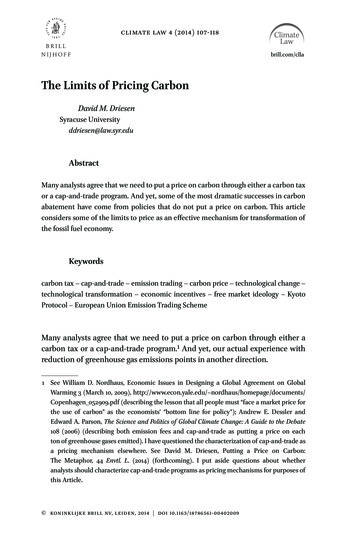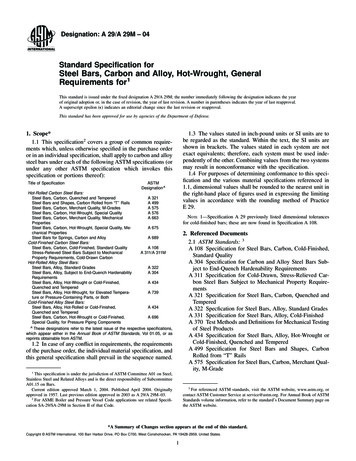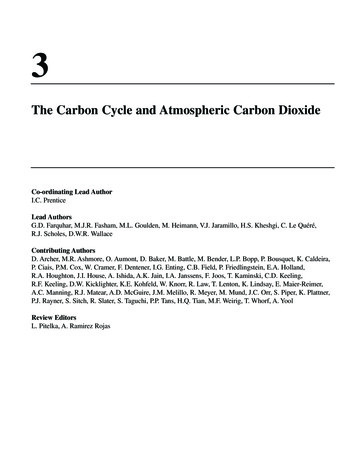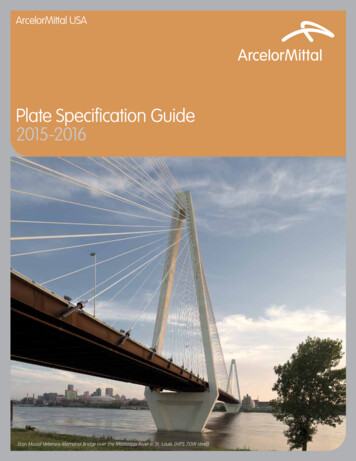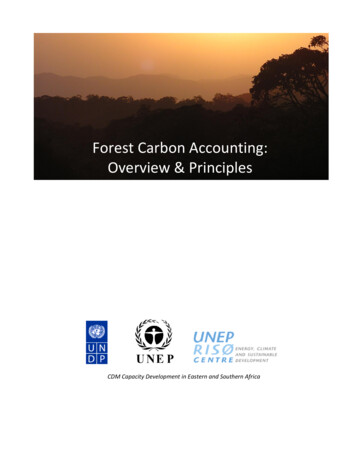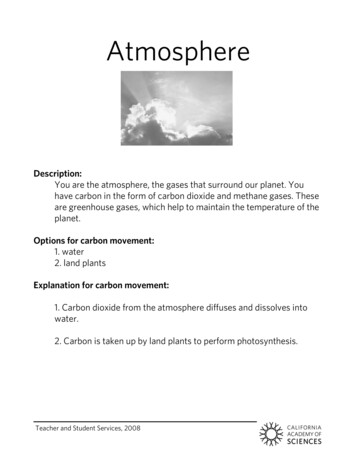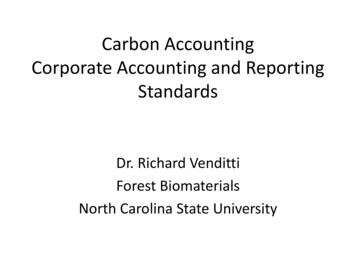
Transcription
Carbon AccountingCorporate Accounting and ReportingStandardsDr. Richard VendittiForest BiomaterialsNorth Carolina State University
Two major standard methods: International Organization for Standardization (ISO) ISO 14064 World Resources Institute and World Business Council forSustainable Development, Greenhouse Gas Protocol (morerobust) If one standard is met, the other is also likely to be met Life Cycle Assessment, Principles Practice and Prospects,Horne, Grant, Verghese, CSIRO Publishing 2009.
Common elements to the two standards: Determining boundaries for GHG accountingClassifying emissionsIdentifying and calculating GHG emissionsProviding rules for changing base year inventoriesProviding rules for tracking emissions over timeProviding rules for assessing uncertaintyProviding rules for reporting Life Cycle Assessment, Principles Practice and Prospects,Horne, Grant, Verghese, CSIRO Publishing 2009.
Greenhouse Gas Protocol Initiative A multi-stakeholder partnership of businesses,nongovernmental organisations (NGOs), governments,academics, and others, convened by: World Resources Institute World Business Council for Sustainable Development Two linked documents:– GHG Protocol Corporate Accounting and Reporting Standard:evaluation of an organization– GHG Protocol Project Quantification Standard: evaluation of a project WWW.ghgprotocol.org
GHG Protocol Corporate Accounting andReporting Standard WWW.ghgprotocol.org
Global trends point to having a GHG inventory Global warming and climate change coming to fore assustainability issues Governments are making national policies including:emissions trading programs, voluntary programs, carbon orenergy taxes, regulations, standards on energy eefficiency andemissions’ Companies must understand their position in GHG’s to ensurelong term success
Business goals served by a GHG inventory : Managing GHG risks and identifying reduction opportunities Public reporting and participation in voluntary GHG programs Participating in mandatory reporting programs– Facilities in Europe under the Integrated Pollution Prevention andControl (IPPC) Directive must report emissions Participating in GHG markets– The Chicago Climate Exchange, CCX, is a voluntary reductionmarketplace consisting of corporations, state and local governmentsand various institutions. Recognition for early voluntary action.
GHG accounting and reporting principles: cy
Setting Organizational boundaries: Equity share approach Under the equity share approach, a company accounts forGHG emissions from operations according to its share ofequity in the operation. Control approach Under the control approach, a company accounts for100percent of the GHG emissions from operations overwhich ithas control. It does not account for GHG emissionsfromoperations in which it owns an interest but has no control.– Can either be financial control or operational control Potential for double counting if 2 companies hold mutualinterests but use different approaches
Setting Operational boundaries: Direct GHG emissions are emissions from sources that areowned or controlled by the company. Indirect GHG emissions are emissions that are a consequenceof the activities of the company but occur at sources ownedor controlled by another company.
Scope 1: Direct GHG emissions: Occur from sources that are owned or controlled by thecompany, for example, emissions from combustion in ownedor controlled boilers, furnaces, vehicles, etc.; emissions fromchemical production in owned or controlled processequipment. Direct CO2 emissions from the combustion of biomass shallnot be included in scope 1 but reported separately (seechapter 9). GHG emissions not covered by the Kyoto Protocol, e.g.CFCs,NOx, etc. shall not be included in scope 1 but maybe reportedseparately (see chapter 9).
Scope 2: Electricity indirect emissions: GHG emissions from the generation of purchased electricityconsumed in its owned or controlled equipment or operationsby the company. Transmission and distribution losses are considered emissionsof the company that controls the T&D operation. Structure to eliminate double counting in scopes 1 and 2
Scope 3: Other indirect GHG emissions A consequence of the activities of the company, but occur fromsources not owned or controlled by the company. Some examples of scope 3 activities are extraction and productionof purchased materials; transportation of purchased fuels; and useof sold products and services. Leased assets, outsourcing, franchises may be accounted in Scope 3 Need not have an extensive GHG LCA of everything.– Describe the value chain– Define which scope 3 emissions are relevant: large, risk exposure, criticalby stakeholders, potential reductions Example where critical: the company’s product uses fossil fuel orelectricity in use. The company can influence company design toreduce GHG emissions. (Levi’s jeans)
DHL Nordic Express: case for accounting foroutsourced services (Scope 3) A major transportation and logistics company Large and special load transport, courier, express, specialtybusiness services. 98% of emissions are form transport of goods by partnertransportation firms. Scope 1: 7265 tCO2 Scope 2: 52 Scope 3: 327,634 Total: 334,951
Setting Organizational and operationalboundaries Organization X is a parent company that has full ownershipand financial control of operations A and B, but only a 30%non operated interest and no financial control in operation C. Choose either equity share or financial control– Equity control: 100% of A and B, 30% of C– Financial control: 100% of A and B, 0% of C Decide whether to account for only scopes 1 and 2 or toinclude scope 3
Example scopes for difft industries: .
Tracking Emissions Over Time Companies may berestructured over time Meaningful comparisonover this time requires arecalculation of historicemission data Choose a base yearemissions No recalculation fororganic growth ordecline. Organic growthis change in productionoutput, product mix,closures/openings withinthe owned/controlledcompany.
Calculating GHG Emissions
Identifying GHG Emissions Stationary combustion: combustion of fuels in boiler as anexample Mobile combustion: fuels combusted in transportationdevices Process emissions: emissions from physical or chemicalprocesses, CO2 from calcining in cement mfg as an example Fugitive emissions: intentional and unintentionalreleases suchas equipment leaks from joints, seals,packing, gaskets, as wellas fugitive emissions fromcoal piles, wastewater treatment,pits, cooling towers,gas processing facilities, etc.
Identifying GHG Emissions Identify scope 1 emissions Identify scope 2 emissions Identify scope 3 emissions (optional): identify emissions fromupstream and downstream and outsourced mfg, leases,franchises not in scopes 1 or 2
Calculating GHG Emissions Direct measurements unlikely More likely– Identify mass flows and stoichiometric relationships in processes– Use documented emissions factors to determine the emissions for aparticular flow– Scope 1 based on flows of fuels purchased, and flows with knownemissions due to stoichiometric considerations– Scope 2 based on meted electricity consumption and supplier specificemission factors– Scope 3 calculated from activity data such as fuel use or passengermiles or published third party emission factors Calculation tools available from ghgprotocol.com
Calculation toolsfromghgprotocol.org
Rolling up GHG emissions data to corporate level Centralized: individual facilitiies report activity/fuel use datato the corporate level where GHG emissions are calculated– Office based organizations where calculations are standard across anumber of facilities Decentralized: individual facilities collect activity/fuel use data, directly calculate GHG emissions and report to the corporatelevel––––If detailed process knowledge is requiredGHG emissions calculation methods vary across facilitiesResources and tools are available at the facilitiesLocal regulations require this at the facilities
Reporting guidance for GHG emissions Description of emission sourcesList and justification of exclusions and inclusionsComparative info from previous yearsReporting period coveredTrends in the dataProgress towards business targetsDiscussion of uncertaintiesDescription of events that impact reported data ( closures,calc methods, boundary changes)
Managing Inventory Quality Developing a credible and unbiased GHG emissions reportrequires some effort in managing quality Provides a system to prevent and correct errors
Accounting for GHG Reductions GHG Protocol Project Quantification Standard focuses on thequantification of GHG reductions from GHG mitigationprojects that will be used as offsets. Offsets are discrete GHG reductions used to compensate for(i.e.,offset) GHG emissions elsewhere, for example to meet avoluntary or mandatory GHG target or cap. Offsets are calculated relative to a baseline that represents ahypothetical scenario for what emissions would have been inthe absence of the project.
Accounting for GHG Reductions Baseline selection, what would happen if the project did notoccur Demonstration of additionality,– must demonstrate reductions AND– show that the project itself is not the baseline, that if the project wentaway their would be higher global emissions (ie., non-additional) ID and quantify relevant secondary (unintended effects) ofproject Consideration of reversibility, that reductions are temporary Avoidance of double counting, defining scope
Example: Accounting for GHG Reductions Alcoa (aluminum mfg) wants to implement strategies to lowerits GHG emissions Purchases renewable energy certificates (RECs) whichrepresent the enviromental benefits from electricitygenerated from renewable rather than fossil fuel sources In 2003 purchased RECs equivalent to 100% of electricity usein 4 corporate offices in TN, PA, NY Electricity from land fill gas avoiding 6.3 million kg of CO2annually
Reporting GHG Emissions Reported information shall be “relevant, complete,consistent, transparentand accurate.” The following is required: Methods and boundaries The GHG Protocol Corporate Standard requires reporting a minimum oftotal scope 1 and scope 2 emissions, independent of GHG trades. Emissions data separately for each scope. Emissions data for all six GHGs separately (CO2, CH4,N2O, HFCs, PFCs, SF6)in metric tonnes and in tonnesof CO2 equivalent. Base case year results and explanations of recalculations Emissions data for direct CO2 emissions from biologicallysequesteredcarbon (e.g., CO2 from burningbiomass/biofuels), reported separatelyfrom the scopes. Methods used for calculations including tools Specific exclusions of sources, facilities or operations
Reporting GHG Reductions Required Company and Inventory Boundary–––– Organizational boundary and consolidation approachOutline of oprerational boundary and if Scope 3 is included with list of activiities coveredReporting periodTotal scope Baseline selection, what would happen if the project did not occurRequired Info on EmissionsTotal scope 1 and 2 emissions independent of anyGHG trades such as sales, purchases, transfers, orbanking of allowances. Emissions data separately for each scope. Emissions data for all six GHGs separately (CO2, CH4,N2O, HFCs, PFCs, SF6) in metric tonnes and in tonnesof CO2 equivalent. Year chosen as base year, and an emissions profile overtime Appropriate context for any significant emissionschanges that trigger base year emissions recalculation Emissions data for direct CO2 emissions from biologicallysequestered carbon (e.g., CO2 from burningbiomass/biofuels), reported separately from the scopes. Methodologies used to calculate or measure emissions,providing a reference or link to any calculation tools used. Any specific exclusions of sources, facilities,and / or operations.
Reporting GHG Emissions Optional items–––––––––Scope 3 emissionsFurther divided data (eg. By facility)Emissions from self generated electricity, heat or steam sold externallyPerformance against benchmarksEmissions from GHGs not covered by the KyotoProtocol (e.g., CFCs, NOx,),reported separately from scopes.OthersInformation on offsets that have been purchased ordeveloped outside theinventory boundary, and if certifiedInformation on reductions at sources inside the inventoryboundary thathave been sold/transferred asoffsets to a third party and if certifiedReporting on ratio indicators
Verification of GHG Emissions Information is considered to be material if, by its inclusion orexclusion,it can be seen to influence any decisions or actions taken by users of it. A material discrepancy is an error(for example, from an oversight,omission or miscalculation)that results in a reported quantity orstatementbeing significantly different to the true value or meaning. An error is considered materially misleading if tis value exceeds 5%of the total inventory for the part of the organization being verified. Independent verifiers are useful (PricewaterhouseCoopers)evaluate both– Whether GHG accounting and reporting has been correctly implemented– Identification of any material discrepancies.
Setting a GHG Target Minimizing and managing GHG risksAchieving cost savingsStimulation innovationPreparing for future regulationsDemonstrating leadership and corporate responsibilityParticipating in voluntary programs
Setting a GHG Target
Questions?
emissions trading programs, voluntary programs, carbon or energy taxes, regulations, standards on energy eefficiency and emissions' Companies must understand their position in GHG's to ensure long term success . Business goals served by a GHG inventory :
